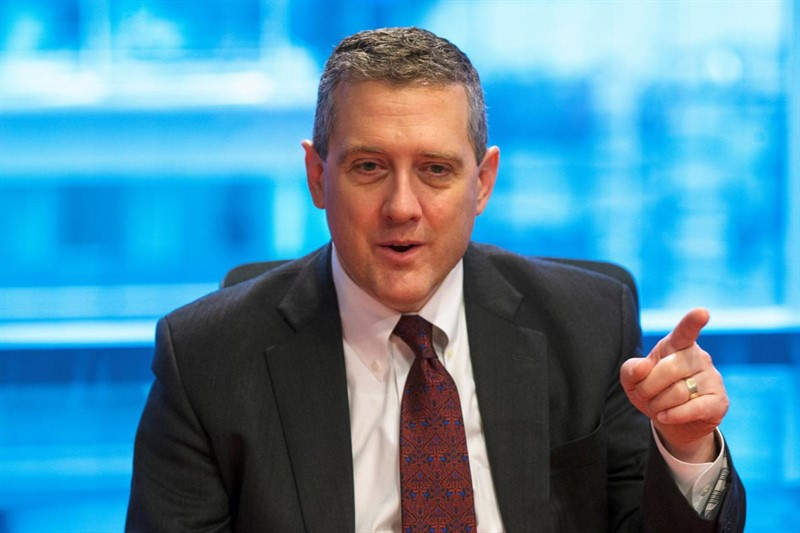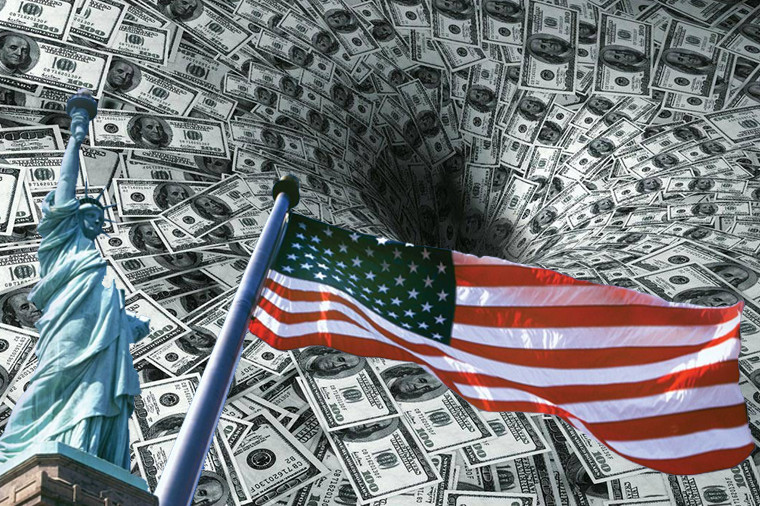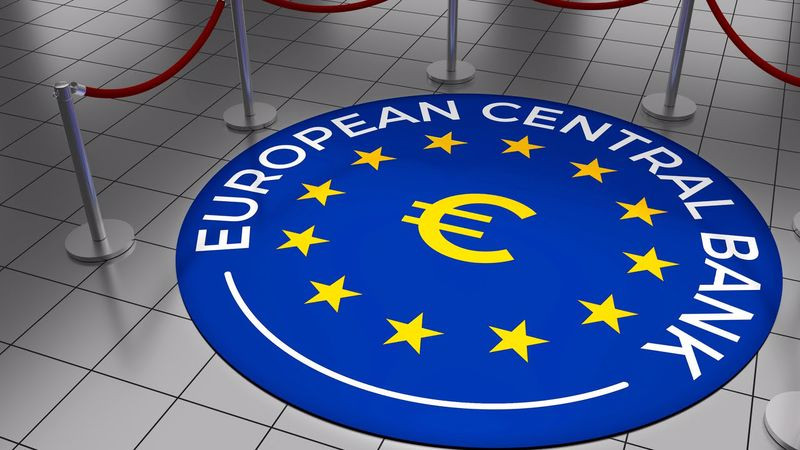

The greenback loosened its grip a bit after climbing back to 20-year-old peaks last week.
Since then, the US currency has lost more than 1% in weight. However, experts note that in the future USD may resume growth.
While dollar bulls are gathering strength for a new dash to the upside, investors are assessing the risks that leading central banks will push the global economy into recession, trying to curb inflation by raising interest rates.
"The global economy is waiting for a weakening of growth rates, high inflation and tightening of monetary conditions. The world's largest economies will suffer from various causes," analysts at Capital Economics predict.
"The deterioration of risk appetite in global markets, as well as the aggressive tightening of policy by the Federal Reserve, will contribute to the strengthening of the US currency," they believe.
The USD index may drift to the area of 105.00-105.50 amid the hawkish position of the Fed and the difficult international situation, which puts pressure on risky assets, ING strategists believe.
One of the central events of this week, literally and figuratively, was the speech of Federal Reserve Chairman Jerome Powell in the Banking Committee of the Senate of the US Congress.
The head of the US central bank appeared before lawmakers a week after the central bank raised the key rate by 75 basis points for the first time since 1994, and found himself under fire from both the left and the right.
Elizabeth Warren, a Democratic senator from Massachusetts, criticized the Fed for insisting on raising rates, which increased the risk of a recession that could leave millions of people out of work.
Republican Senator John Kennedy of Louisiana, in turn, pointed to the Fed's belated reaction to inflation. He said that inflation is hitting his voters so hard that they are coughing up bones.
In general, Powell did not deviate much from his remarks at the press conference following the Fed's latest monetary policy decision. However, this time his statements sounded more alarming than a week ago.
Powell said that the central bank is fully committed to establishing control over prices, even if it is fraught with an economic downturn.
He noted that a recession is undoubtedly possible, although this is not a scenario that Fed officials are striving for.
He reiterated that the continued increase in the key interest rate is appropriate. At the same time, the exact pace of the rate hike, according to Powell, depends on the economic prospects.
Powell refused to rule out a rate hike of 100 basis points if it turns out to be justified.
"Inflation has obviously unexpectedly increased over the past year, and there may be other surprises," he said, repeating that the central bank needs to be flexible in response to incoming data.

On Wednesday, a number of Fed policymakers spoke of the central bank likely needing to raise rates by either 50 or 75 basis points at its next meeting in July.
Chicago Fed President Charles Evans has signaled that he will support another significant rate hike in July if inflation data does not improve.
"The Fed remains focused on blowing off steam due to price pressure. I think a 75 basis point rate hike would be in line with ongoing fears that inflation is not falling as fast as we thought," Evans said, acknowledging the growing risk of a recession.
"Rapid rate hikes do increase the risk of an economic downturn," he said.Philadelphia Fed Chairman Patrick Harker believes that the US economy may experience a moderate recession in the near future.
"We could have a couple of quarters with negative dynamics," Harker said, adding that at the July meeting he could support both a 50 bp rate hike and a 75 bp hike, but that would depend on the statistics that will appear by then.
Comments by Powell and his colleagues led to the fact that the yield of 10-year treasuries on Wednesday fell to almost a two-week low, pulling the US currency with it.
Following the results of the previous day's trading, the greenback plunged by more than 0.3% and finished in the region of 104.00.
"Powell's speech slightly weakened the dollar, as his comments about heightened recession risk mattered more to the market than his unconditional commitment to restoring price stability," Westpac strategists said.
They see the risk of a pullback of the USD index to the level of 102 in the short term, but still recommend buying the US currency on the decline.
"Taking into account the fact that the increase in the Fed's key rate in July by 75 bp is still under consideration and US borrowing costs should rise above 3% by the end of the year, this will continue to support the dollar," Westpac said.
US stock indexes also finished trading Wednesday with a moderate decline after Powell's speech. In particular, the S&P 500 plunged 0.13% to 3759.89 points. The index failed to build on the positive momentum of the previous day.
On Tuesday, the S&P 500 gained about 2.5% in what turned out to be just a "bounce".
The market welcomed the statement of US President Joe Biden who said over the weekend that a US recession does not yet look inevitable.
Also, investors have adopted the point of view of St. Louis Fed President James Bullard, who has long called for a quick increase in interest rates and bring them to 3.5%. According to him, this will allow inflation to be brought under control, as a result of which, at the end of 2023, conditions may arise for lowering rates.

Comments by Bullard were in the spirit of investors who felt that they reacted too emotionally last week to the Fed rate hike by 75 bps. They believed that an aggressive rate hike in the coming months would bear fruit and allow the US central bank to curb inflation. Added to this were hopes that corporate earnings in the second quarter would bring more positive surprises than negative ones.
In this scenario, stocks should return to an upward trajectory, and the dollar will weaken.
However, the last word, as you know, remains with Powell. And he brought stock indexes back from heaven to earth, reminding us that life is much more complicated than it seems.
Powell said that the central bank will stop the cycle of raising the key rate if it registers clear signs of slowing inflation in the country.
However, the conflict in Ukraine and the quarantine due to COVID-19 in China continue to put upward pressure on inflation. These are the factors that the Fed can least influence by raising rates.
The S&P 500 index moved into a bear market at the beginning of last week, and then recovered sharply on Tuesday, but US stocks on Wednesday showed that the rebound may be short-lived.
"To start a sustained rally of the US stock market, we need to see that inflation and the hawkish attitude of the Federal Reserve have reached a peak," Sevens Report Research analysts said.
This year, the USD index has grown by more than 8%, reflecting the general unwillingness of investors to take risks and the advantage of the dollar in profitability due to the Fed.
Meanwhile, the S&P 500 has declined by 21% since the beginning of the year amid expectations that a toxic mix of high inflation and aggressive actions by the Fed will lead the US economy into recession.
The S&P 500 index is now preparing for the worst first half of the year since the reign of Richard Nixon in the United States, Bloomberg reports.
According to the agency, the last time the S&P 500 fell so much during the first six months was only in the 1970s.
"An inflationary shock in the style of the 1970s could lead to a drop in the S&P 500 index by about 33% from current levels to 2525 against the background of economic stagnation and higher inflation," Societe Generale strategists noted.
"A key takeaway from the 1970s is the risk that if investors start to believe that inflation will remain high for longer, stock markets will start to focus on the real, rather than the nominal rate of earnings per share, which is likely to be negative this year," they added.
At the same time, much will depend on what the Fed ultimately chooses, the fight against inflation or the maintenance of financial stability.
The fact is that over the past decades, the American economy has accumulated a huge debt, which, according to data for the first quarter of 2022, amounts to almost $67 trillion.

Even with current expectations of a 3.5% increase in the federal funds rate by the end of this year, the cost of servicing US debt will skyrocket.
Therefore, there is reason to believe that the Fed will still make a choice not in favor of fighting inflation to the bitter end.
Thus, high inflation is likely to stay with the Americans for a long time, and in the not too distant future we may see a situation of stagflation in the United States, when the rapid rise in prices will be accompanied by a slowdown in economic growth.
However, this will all be later, but for now, the key Wall Street indices are trying to stabilize at the levels reached, since most of the negative news has already been taken into account in quotes.
As for the greenback, dollar bulls are accustomed to the hawkish rhetoric of Fed officials, and a new push for the USD to the upside will require either full-scale risk aversion or increased expectations of a 100 basis point Fed rate hike. Neither of these have yet been observed.
The greenback regained its composure on Thursday after three consecutive days of pullbacks.
A breakthrough above 104.60 would target the US currency at 104.94 (weekly high of June 22) and then lead to 105.78 (2022 high of June 15) and 107.30 (December 2002 monthly high).
On the other hand, initial support lies at 103.40 (weekly low of June 16), followed by 102.70 (55-day moving average) and 101.30 (monthly low of May 30).
While the dollar is trying to decide on a further vector of movement, the EUR/USD pair has found shelter in the range of 1.0450-1.0600.
Since the beginning of the year, the euro has fallen in price against the greenback by more than 7%.
Due to the continued interest rate differential between the eurozone and the US, the EUR/USD pair may extend the downward trend in the near term, however, the medium-term outlook looks more favorable for the euro, economists at ANZ Bank say.
"In the short term, the strengthening of the dollar may continue. However, we are not sure that the dollar will continue to strengthen in the medium term. First, we expect the ECB to become more hawkish. Second, we believe that the central bank is determined to prevent fragmentation. Third, the ECB's policy becomes positive for the euro as fiscal policy expands. Fiscal expansion and monetary tightening create a favorable environment for the eurozone, whose terms of trade will also recover in the medium term," they said.
While analysts at MUFG Bank continue to be bearish on the pair, they point to eurozone-US yield spreads shifting in favor of a stronger euro as central bank divergences on both sides of the Atlantic narrowed.
"The main upside risk to our bearish EUR/USD outlook could come from easing concerns about energy supplies to Europe. While we believe that this is unlikely in the next month, the euro is well positioned to rebound if concerns about eurozone economic growth ease," they said.
Eurozone business data released on Wednesday showed that the currency bloc's Composite Purchasing Managers' Index fell from 54.8 in May to 51.9 in June, well below the forecasted 54.0.
"The lower-than-expected PMI fuels debate about worsening economic growth in the eurozone and raises the question of how much the ECB can really raise rates," Societe Generale strategists said.

Most experts interviewed recently by Reuters believe that the ECB will raise its discount rate by 25 basis points in July, and then by another 50 basis points in September, bringing the deposit rate from negative territory to 0.25%.
Answering an additional question, respondents said that the probability of a recession in the eurozone during the year is about one in three.
"The ECB is making a dash to a neutral exchange rate to stop the growth of underlying inflationary pressure. The risks for the short-term prospects are shifted towards faster rate hikes. Not least because of the likely surprises of rising inflation, but also because the presence of a support mechanism to some extent mitigates concerns about potential side effects for peripheral spreads," BNP Paribas analysts noted.
The main goal of the ECB is to maintain inflation in the eurozone at 2% in the medium term, ECB President Christine Lagarde said on Monday.
The ECB's current forecast assumes inflation at 6.8% this year, 3.5% in 2023 and 2.1% in 2024.
Lagarde also said that the central bank should monitor the impact of its policy in the field of price normalization on the eurozone economy. So far, the ECB's main forecast does not imply a drop in the region's GDP. For the current year, it is expected to grow by 2.8%, and for 2023 and 2024 – by 2.1%.
"We expect that the weakness of economic growth will become more evident in the coming months, which should make the ECB cautious. A moderate decline is currently our baseline forecast," Rabobank analysts said.
"A recession will force the ECB to end its rate hike cycle, but if inflation or inflation expectations show no signs of abating, the central bank will be forced to continue raising rates despite such a downturn," they added.
Disappointing data on the eurozone PMI index forced the single currency to break a three-day winning streak against the US dollar. The day before, the EUR/USD pair rose by almost 0.3%.
Having spent Thursday's Asian session in a relatively narrow range below the 1.0600 mark, it then lost sideways momentum and tested the 1.0500 level before slightly reducing losses.
The nearest support is 1.0470 (the Fibonacci correction level by 23.6%). If this mark turns into resistance, additional losses in the direction of 1.0400 and 1.0380 are possible.
The initial resistance is at 1.0520 (38.2% Fibonacci retracement level), and then at 1.0560 (50% Fibonacci retracement level) and 1.0580 (200-day moving average).

TAUTAN CEPAT